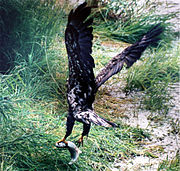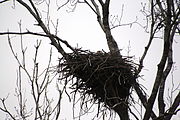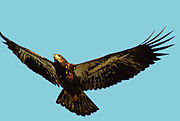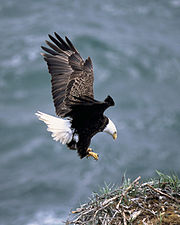
Bald Eagle
Did you know...
The articles in this Schools selection have been arranged by curriculum topic thanks to SOS Children volunteers. Before you decide about sponsoring a child, why not learn about different sponsorship charities first?
| Bald Eagle | |
|---|---|
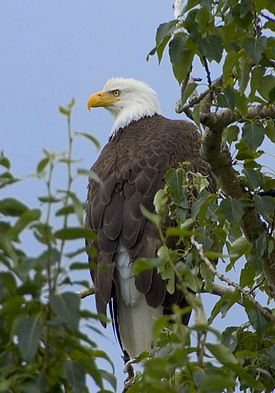 |
|
| Conservation status | |
|
Least Concern ( IUCN 3.1) |
|
| Scientific classification | |
| Kingdom: | Animalia |
| Phylum: | Chordata |
| Class: | Aves |
| Order: | Falconiformes |
| Family: | Accipitridae |
| Genus: | Haliaeetus |
| Species: | H. leucocephalus |
| Binomial name | |
| Haliaeetus leucocephalus (Linnaeus, 1766) |
|
| Subspecies | |
|
|
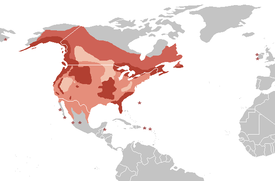 |
|
| Bald Eagle range Resident, breeding
Summer visitor, breeding
Winter visitor
On migration only Star: accidental records |
|
| Synonyms | |
|
Falco leucocephalus Linnaeus, 1766 |
|
The Bald Eagle (Haliaeetus leucocephalus) is a bird of prey found in North America that is most recognizable as the national bird and symbol of the United States of America. This sea eagle has two known sub-species and forms a species pair with the White-tailed Eagle. Its range includes most of Canada and Alaska, all of the contiguous United States and northern Mexico. It is found near large bodies of open water with an abundant food supply and old-growth trees for nesting.
The Bald Eagle is a large bird, with a body length of 71–96 centimeters (28–38 in), a wingspan of 168–244 centimeters (66–88 in), and a mass of 3–6.3 kilograms (6.6–14 lb); females are about 25 percent larger than males. The adult Bald Eagle has a brown body with a white head and tail, and bright yellow irises, taloned feet, and a hooked beak; juveniles are completely brown except for the yellow feet. Males and females are identical in plumage coloration. Its diet consists mainly of fish, but it is an opportunistic feeder. It hunts fish by swooping down and snatching the fish out of the water with its talons. It is sexually mature at four years or five years of age. The Bald Eagle builds the largest nest of any North American bird, up to 4 meters (13 ft) deep, 2.5 meters (8 ft) wide, and one tonne (1.1 tons) in weight.
The species was on the brink of extirpation in the continental United States (while flourishing in much of Alaska and Canada) late in the 20th century, but now has a stable population and has been officially removed from the U.S. federal government's list of endangered species. The Bald Eagle was officially reclassified from "Endangered" to " Threatened" on July 12, 1995 by the United States Fish and Wildlife Service. On July 6, 1999, a proposal was initiated "To Remove the Bald Eagle in the Lower 48 States From the List of Endangered and Threatened Wildlife." It was delisted on June 28, 2007.
Description
The plumage of an adult Bald Eagle is evenly brown with a white head and tail. The tail is moderately long and slightly wedge-shaped. Males and females are identical in plumage coloration, however females display reverse sexual dimorphism and are 25 percent larger than males. The beak, feet, and irises are bright yellow. The legs are unfeathered, and the toes are short and powerful with large talons. The highly developed talon of the hind toe is used to pierce the vital areas of prey while it is held immobile by the front toes. The beak is large and hooked, with a yellow cere.
The plumage of the immature is brown, speckled with white until the fifth (rarely fourth, very rarely third) year, when it reaches sexual maturity. Immature Bald Eagles are distinguishable from the Golden Eagle in that the former has a more protruding head with a larger bill, straighter edged wings which are held flat (not slightly raised) and with a stiffer wing beat, and feathers which do not completely cover the legs. Also, the immature Bald Eagle has more light feathers in the upper arm area, especially around the very top of the arm.
Body length ranges from 71 to 96 cm (28–38 in). Adult females have a wingspan of up to 2.44 m (88 in), while adult males may be as small as 1.68 m (66 in). Adult females weigh approximately 5.8 kg (12.8 lb), males weigh 4.1 kg (9 lb). The size of the bird varies by location; the smallest specimens are those from Florida, where an adult male may barely exceed 2.3 kg (5 lb) and a wingspan of 1.8 m (6 ft). The largest are Alaskan birds, where large females may exceed 7.5 kg (16.5 lb) and have a wingspan of over 2.4 m (8 ft).
Taxonomy
This sea eagle gets both its common and scientific names from the distinctive appearance of the adult's head. Bald in the English name is derived from the word piebald, and refers to the white head and tail feathers and their contrast with the darker body. The scientific name is derived from Haliaeetus, New Latin for "sea eagle" (from the Ancient Greek haliaetos), and leucocephalus, Latinized Ancient Greek for "white head," from λευκος leukos ("white") and κεφαλη kephale ("head").
The Bald Eagle was one of the many species originally described by Linnaeus in his 18th century work Systema Naturae, under the name Falco leucocephalus.
There are two recognized subspecies of Bald Eagle:
- H. l. leucocephalus (Linnaeus, 1766) is the nominate subspecies. It is separated from H. l. alascanus at approximately latitude 38° N, or roughly the latitude of San Francisco. It is found in the southern United States and Baja California.
- H. l. washingtoniensis (Audubon, 1827), synonym H. l. alascanus Townsend, 1897, the northern subspecies, is larger than southern nominate leucocephalus. It is found in the northern United States, Canada and Alaska. This subspecies reaches further south than latitude 38° N on the Atlantic Coast, where they occur in the Cape Hatteras area.
The Bald Eagle forms a species pair with the Eurasian White-tailed Eagle. This species pair consists of a white-headed and a tan-headed species of roughly equal size; the White-tailed Eagle also has overall somewhat paler brown body plumage. The pair diverged from other Sea Eagles at the beginning of the Early Miocene (c. 10 Ma BP) at the latest, but possibly as early as the Early/Middle Oligocene, 28 Ma BP, if the most ancient fossil record is correctly assigned to this genus. The two species probably diverged in the North Pacific, as the White-tailed Eagle spread westwards into Eurasia and the Bald Eagle spread eastwards into North America.
Habitat and range
The Bald Eagle prefers habitats near seacoasts, rivers, large lakes, and other large bodies of open water with an abundance of fish. Studies have shown a preference for bodies of water with a circumference greater than 11 km (7 miles), and lakes with an area greater than 10 km² (3.8 square miles) are optimal for breeding bald eagles.
The Bald Eagle requires old-growth and mature stands of coniferous or hardwood trees for perching, roosting, and nesting. Selected trees must have good visibility, an open structure, and proximity to prey, but the height or species of tree is not as important as an abundance of comparatively large trees surrounding the body of water. Forests used for nesting should have a canopy cover of less than 60 percent, and as low as 20 percent, and be in close proximity to water.
The Bald Eagle is extremely sensitive to human activity, and occurs most commonly in areas free of human disturbance. It chooses sites more than 1.2 km (0.75 miles) from low-density human disturbance and more than 1.8 km (1.2 miles) from medium- to high-density human disturbance.
The Bald Eagle's natural range covers most of North America, including most of Canada, all of the continental United States, and northern Mexico. It is the only Sea Eagle native to only North America. The bird itself is able to live in most of North America's varied habitats from the bayous of Louisiana to the Sonoran Desert and the eastern deciduous forests of Quebec and New England. Northern birds are migratory, while southern birds are resident, often remaining on their breeding territory all year. The Bald Eagle previously bred throughout much of its range but at its lowest population was largely restricted to Alaska, the Aleutian Islands, northern and eastern Canada, and Florida.
It has occurred as a vagrant twice in Ireland; a juvenile was shot illegally in Fermanagh on January 11, 1973 (misidentified at first as a White-tailed Eagle), and an exhausted juvenile was captured in Kerry on November 15, 1987. Bald Eagles will also congregate in certain locations in winter. From November until February, one to two thousand birds winter in Squamish, British Columbia, about halfway between Vancouver and Whistler. The birds primarily gather along the Squamish and Cheakamus Rivers, attracted by the salmon spawning in the area.
Behaviour
The Bald Eagle is a powerful flier, and soars on thermal convection currents. It reaches speeds of 56–70 km/h (35–44 miles per hour) when gliding and flapping, and about 48 km/h (30 miles per hour) while carrying fish. It is partially migratory, depending on location. If its territory has access to open water, it remains there year-round, but if the body of water freezes during the winter, making it impossible to obtain food, it migrates to the south or to the coast. The Bald Eagle selects migration routes which take advantage of thermals, updrafts, and food resources. During migration, it may ascend in a thermal and then glide down, or may take ascend in updrafts created by the wind against a cliff or other terrain. Migration generally takes place during the daytime, when thermals are produced by the sun.
Bald Eagles normally squeak and have a shrill cry, punctuated by grunts. They do not make the scream that is found in films; this is usually the call of a Red-tailed Hawk, dubbed into films for dramatic effect.
Diet
The Bald Eagle's diet is opportunistic and varied, but most feed mainly on fish. In the Pacific Northwest, spawning trout and salmon provide most of the Bald Eagles' diet. Locally, eagles may rely largely on carrion, especially in winter, and they will scavenge carcasses up to the size of whales, though it seems that carcasses of ungulates and large fish are preferred. They also may sometimes feed on subsistence scavenged or stolen from campsites and picnics, as well as garbage dumps. Mammalian prey includes rabbits, hares, raccoons, muskrats, beavers, sea otters, and deer fawns. Preferred avian prey includes grebes, alcids, ducks, gulls, coots, egrets and geese. Most live prey are quite a bit smaller than the eagle, but predatory attacks on large birds such as the Great Blue Heron and even swans have been recorded. Reptiles, amphibians and crustaceans (especially crabs) are preyed on when available.
To hunt fish, easily their most important live prey, the eagle swoops down over the water and snatches the fish out of the water with its talons. They eat by holding the fish in one claw and tearing the flesh with the other. Eagles have structures on their toes called spiricules that allow them to grasp fish. Osprey also have this adaptation. Bald Eagles have powerful talons.
Sometimes, if the fish is too heavy to lift, the eagle will be dragged into the water. It may swim to safety, but some eagles drown or succumb to hypothermia. When competing for food, eagles will usually dominate other fish-eaters and scavengers, aggressively displacing mammals such as coyotes and foxes, and birds such as corvids, gulls, vultures and other raptors. Bald Eagles may be displaced by or themselves displace Golden Eagles, with neither species known to be dominant. Occasionally, Bald Eagles will steal fish away from smaller raptors, such as Ospreys, a practice known as kleptoparasitism.
Reproduction
Bald Eagles are sexually mature at four or five years of age. When they are old enough to breed, they often return to the area where they were born. It is thought that Bald Eagles mate for life. However, if one member of a pair dies or disappears, the other will choose a new mate. A pair which has repeatedly failed in breeding attempts may split and look for new mates. Bald Eagle courtship involves elaborate calls and flight displays. The flight includes swoops, chases, and cartwheels, in which they fly high, lock talons, and free fall, separating just before hitting the ground.
The nest is the largest of any bird in North America; it is used repeatedly over many years and with new material added each year may eventually be as large as 4 meters (13 ft) deep, 2.5 meters (8 ft) across and weigh one tonne (1.1 tons); one nest in Florida was found to be 6.1 meters deep (20 ft), 2.9 meters (9.5 ft) across, and to weigh 2.722 tonnes (3 tons). The nest is built out of branches, usually in large trees near water. When breeding where there are no trees, the Bald Eagle will nest on the ground. Eagles produce between one and three eggs per year, but it is rare for all three chicks to successfully fly. Both the male and female take turns incubating the eggs. The other parent will hunt for food or look for nesting material. The eggs average about 7.3 centimeters (2.9 in) long and have a breadth of 5.5 centimeters (2.2 in).
The incubation period averages at about 35 days and the parents will brood their offspring until they are about four weeks of age. The fledging stage can occur at any time from 70 to 92 days, the wide variation dictated by the effects of sex and hatching order on growth and development. Egg and nestling predation may be committed by Black-billed Magpies, gulls, ravens and crows, black bears and raccoons. With no known predators themselves, adults will fiercely defend their offspring from these species.
Relationship with humans
Population decline and recovery
Once a common sight in much of the continent, the Bald Eagle was severely affected in the mid-20th century by a variety of factors, among them thinning of egg shells, attributed to the use of the pesticide DDT. Bald Eagles, like many birds of prey, were especially affected by DDT due to biomagnification. DDT itself was not lethal to the adult bird, but it interfered with the bird's calcium metabolism, making the bird either sterile or unable to lay healthy eggs. Female eagles laid eggs that were too brittle to withstand the weight of a brooding adult, making it nearly impossible to produce young. It's estimated that in the early 1700s, the bald eagle population was 300,000–500,000, but by the 1950s there were only 412 nesting pairs in the 48 contiguous states of the US. Other factors in Bald Eagle population reductions were a widespread loss of suitable habitat, and illegal shooting, which was described as "the leading cause of direct mortality in both adult and immature bald eagles," according to a 1978 report in the Endangered Species Technical Bulletin. In 1984, the National Wildlife Federation listed hunting, power line electrocution, and collisions in flight as the leading causes of eagle deaths. Bald Eagle populations have also been negatively affected by oil, lead, and mercury pollution, and by human and predator intrusion.
The species was first protected in the U.S. and Canada by the 1918 Migratory Bird Treaty, later extended to all of North America. The 1940 Bald Eagle Protection Act in the U.S., which protected the Bald Eagle and the Golden Eagle, prohibited commercial trapping and killing of the birds. The Bald Eagle was declared an endangered species in the U.S. in 1967, and amendments to the 1940 act between 1962 and 1972 further restricted commercial uses and increased penalties for violators. Also in 1972, DDT was banned in the United States. DDT was completely banned in Canada in 1989, though its use had been highly restricted since the late 1970s.
With regulations in place and DDT banned, the eagle population rebounded. The Bald Eagle can be found in growing concentrations throughout the United States and Canada, particularly near large bodies of water. In the early 1980s, the estimated total population was 100,000 birds, with 110,000–115,000 by 1992; the U.S. state with the largest resident population is Alaska, with about 40,000–50,000 birds, with the next highest population being the Canadian province of British Columbia with 20,000–30,000 birds in 1992.
It was officially removed from the U.S. federal government's list of endangered species on July 12, 1995 by the U.S. Fish & Wildlife Service, when it was reclassified from "Endangered" to "Threatened." On July 6, 1999, a proposal was initiated "To Remove the Bald Eagle in the Lower 48 States From the List of Endangered and Threatened Wildlife." It was delisted on June 28, 2007. It has also been assigned a risk level of Least Concern category on the IUCN Red List.
In captivity
Permits are required to keep Bald Eagles in captivity in the United States. Permits are primarily issued to public educational institutions, and the eagles which they show are permanently injured individuals which cannot be released to the wild. The facilities where eagles are kept must be equipped with adequate caging and facilities, as well as workers experienced in the handling and care of eagles. Bald Eagles cannot legally be kept for falconry in the United States. As a rule, the Bald Eagle is a poor choice for public shows, being timid, prone to becoming highly stressed, and unpredictable in nature. Native American Tribes can obtain a "Native American Religious Use" permit to keep non-releasable eagles as well. They use their naturally molted feathers for religious and cultural ceremonies. The Bald Eagle can be long-lived in captivity if well cared for, but does not breed well even under the best conditions. In Canada, a license is required to keep Bald Eagles for falconry.
National bird of the United States
The Bald Eagle is the national bird of the United States of America. It is one of the country's most recognizable symbols, and appears on most of its official seals, including the Seal of the President of the United States.
The Continental Congress adopted the current design for the Great Seal of the United States including a Bald Eagle grasping thirteen arrows and a thirteen-leaf olive branch with its talons on June 20, 1782.
After the end of the Revolutionary War, Benjamin Franklin wrote a famous letter from Paris in 1784, to his daughter, criticizing the choice and suggesting the Wild Turkey as a better representative of American qualities. He described the Bald Eagle as "a Bird of bad moral character," who, "too lazy to fish for himself" survived by robbing the Osprey. He called the Bald Eagle "a rank Coward" easily driven from a perch by the much smaller kingbird. In the letter, Franklin wrote the Turkey is, "a much more respectable Bird," which he described as "a little vain & silly [but] a Bird of Courage."
The Bald Eagle remained the emblem of the United States. It can be found on both national seals and on the back of several coins (including the quarter dollar coin until 1999), with its head oriented towards the olive branch. Between 1916 and 1945, the Presidential Flag showed an eagle facing to its left (the viewer's right), which gave rise to the urban legend that the seal is changed to have the eagle face towards the olive branch in peace, and towards the arrows in wartime.
Role in Native American culture
The Bald Eagle is a sacred bird in some North American cultures, and its feathers, like those of the Golden Eagle, are central to many religious and spiritual customs among Native Americans. Eagles are considered spiritual messengers between gods and humans by some cultures. Many pow wow dancers use the eagle claw as part of their regalia as well. Eagle feathers are often used in traditional ceremonies, particularly in the construction of regalia worn and as a part of fans, bustles and head dresses. The Lakota, for instance, give an eagle feather as a symbol of honour to person who achieves a task. In modern times, it may be given on an event such as a graduation from college. The Pawnee considered eagles as symbols of fertility because their nests are built high off the ground and because they fiercely protect their young. The Kwakwaka'wakw scattered eagle down to welcome important guests.
During the Sun Dance, which is practiced by many Plains Indian tribes, the eagle is represented in several ways. The eagle nest is represented by the fork of the lodge where the dance is held. A whistle made from the wing bone of an eagle is used during the course of the dance. Also during the dance, a medicine man may direct his fan, which is made of eagle feathers, to people who seek to be healed. The medicine man touches the fan to the centre pole and then to the patient, in order to transmit power from the pole to the patient. The fan is then held up toward the sky, so that the eagle may carry the prayers for the sick to the Creator.
Current eagle feather law stipulates that only individuals of certifiable Native American ancestry enrolled in a federally recognized tribe are legally authorized to obtain Bald or Golden Eagle feathers for religious or spiritual use. The constitutionality of these laws has been questioned by Native American groups on the basis that it violates the First Amendment by affecting ability to practice their religion freely. Additionally, only members of federally recognized tribes are legally allowed to possess eagle feathers, preventing non-federally recognized tribe members from practicing religion freely. The laws have also been criticized on grounds of racial preferences and infringements on tribal sovereignty.



